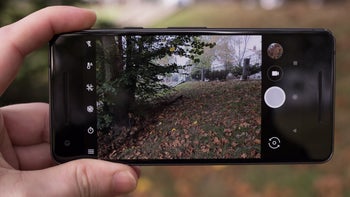Photos reveal Google tested iris recognition using Pixel 2 prototype

As noted by 9to5Google, images of a prototype Pixel 2 were displayed in a tweet posted on Friday by Internal Archives. Yes, the 2017 Pixel 2 series is still fondly remembered by Pixel fans (including this writer who owned the Pixel 2 XL). What made this prototype stand out is that Google outfitted it with an iris recognition system. The 8MP selfie snapper has been replaced by an infrared-filtered front camera. An IR LED is placed on the other side.
Every person has different iris patterns making it one of the safest biometric tools available
An "Iris Demo" app allows users to verify and enroll their irises by lining up their eyes with two circles. This device, Internal Archive says, is "running AOSP, a very blank version of Android, this Pixel is quite bland. It’s obvious that this unit’s only purpose was to test the Iris Recognition, with it missing any other internal tools. Overall, this is a very unique piece of prototype history!"
(1/4) A very rare Google Pixel 2 Walleye Prototype (EVT-E), with a previously undiscovered Iris Recognition system built into the device. To enroll, you line up your eyes and keep them open. Part of the #internalarchivecollectionpic.twitter.com/wrSZ8dbJpS
— Internal Archive (@ArchiveInternal) October 28, 2022
Google has thus far refrained from offering Iris Recognition on the Pixel series although Samsung debuted it with 2017's Galaxy S8/S8+. Samsung promoted Iris Recognition by saying, "The patterns in your irises are unique to you and are virtually impossible to replicate, meaning iris authentication is one of the safest ways to keep your phone locked and the contents private."
When the Galaxy S9 line was released in 2018, Samsung combined Iris Recognition and Face Recognition and called it "Intelligent Scan." Sammy removed Iris Recognition from its phones starting with the Galaxy S10 series so that it could pursue a bezel-less design for its flagship smartphones. Samsung might have removed Iris Recognition just a little early since it would have been perfect for facial recognition with everyone wearing a mask. Of course, fingerprint scanners could also unlock devices during the pandemic.
Google did borrow from Apple's TrueDepth Camera to create a secure version of Face Unlock for the Pixel 4. The feature was missing from both the Pixel 5 and Pixel 6 lines. For the Pixel 7 and Pixel 7 Pro, Google brought back a different version of Face Unlock although it can be used only to unlock the phone. Google doesn't consider it to be secure enough to verify the user's identity for mobile payments, or when opening an app.
The first smartphones to use an iris scanner were released back in 2015
To be considered secure, Google doesn't want a facial recognition system to allow spoofing to unlock a device more than 7% of the time. Reportedly, spoofing will allow someone other than the phone's owner to open a Pixel 7 device using Face Unlock more than 20% of the time. Spoofing is when a person pretends to be someone else, such as the owner of a targeted Pixel 7 series handset.
Interestingly, Google does use iris scanning (along with badges) to secure its data centers.
It was also pointed out to me by one of our loyal readers that certain Microsoft Lumia models also featured iris scanning. The Lumia 950 and 950 XL both had this biometric capability back in 2015. Of course, the lack of a well-stocked app store prevented the platform from gaining any traction. Had developers supported Windows Phone, we could have had a three way battle for smartphone supremacy between iOS, Android, and Windows Phone.
But the aforementioned Lumia models were not the first handsets to include an iris scanner. That honor belongs to the Fujitsu Arrows NX F-04G which had a feature called Iris Passport. This Android phone came to market just a few months before the Lumia 950 and 950 XL.










Things that are NOT allowed: